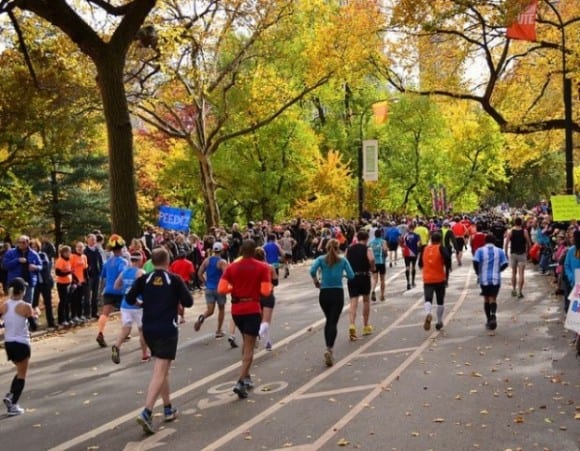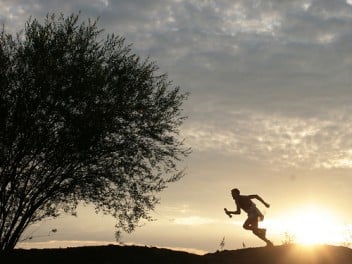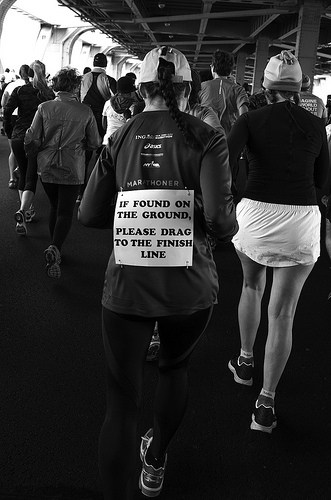Wave after wave of sweaty, exhausted strangers passed me by. Laboring for each breath of air, their contorted faces grimaced in visible pain with every step. I stood there staring, surrounded by screaming onlookers.
Friends said I was crazy to trek down to Central Park among throngs of spectators and heightened NYPD security to watch the 2013 New York City marathon. I didn’t know anyone running the race; I wasn’t carrying a sign to cheer on a friend or family member. What was I doing there?
* * *
Beginning in 1970, the New York City marathon has run every year, with one notable exception. Last year, Superstorm Sandy ripped through the East Coast a week before the marathon was scheduled. The damage was widespread: we can all recall images of the flooding, stories of people going days without electricity, the accounts of the fires that followed.
I remember reading about the marathon after the storm blazed through. At first planners announced that the marathon would run as planned. Their rationale: think about all the people who train for months to prepare – this was going to be their big day! And keep in mind that participants travel from other parts of the country and across the world to be at the event, especially since we’re talking about New York City here. This isn’t just a local church picnic 5K.1 The show must go on! Or so they thought…
The public outcry was swift: how could the city support an event that took runners past the devastated neighborhoods in the wake of a natural disaster? After all, only Hurricane Katrina caused a greater amount of total property damage than Sandy. This was a serious storm. Calmer heads prevailed and the marathon was canceled for the first time in its history. It was an important decision in a city in need of healing and reconstruction, though no doubt disheartening to the registered runners.
In April just a few months later, Boston held the 117th annual running of the Boston marathon, the world’s oldest annual marathon. We all remember the horrific story of that day, when two brothers placed a bomb near the finish line, and detonated it, killing three and maiming hundreds more who were there to watch the race.2
Carrying these recent scars, this year’s New York City marathon became a sign of the city’s resilience since the storm. Runners from last year’s canceled marathon were able to defer their registration to this year. And in light of what happened in Boston, the increased security distinguished this year’s event as different, as changed in light of what happened last April.
That is why I was there: I had to be there. In light of Sandy and the bombing in Boston, the event carried an added significance; I had to be there to experience it.
* * *
Have you ever been to a marathon? It has to be one of the best sporting events to spectate, and not just because it is free. I grant that it sounds a little ridiculous to stand outside as thousands of strangers stream past you.3 But trust me – it’s the best. Unlike so many other (particularly professional) sporting events where the focus is on what the official deodorant of the NFL is or whether $30,000,000 is enough to be paid to play third base, a marathon is about real people. It is uplifting and inspiring– a celebration of the triumph of the human spirit! How much more so this year amid all the emotion of Sandy and last April’s Boston marathon?
This year it was a picture-perfect autumn day, with clear blue skies and bright colors among the trees in Central Park. The sun was shining bright, and I scanned the crowd for Billy Crystal and Meg Ryan.4 The increased security didn’t prevent the course from being lined with spectators, and I made my way with a friend from the Metropolitan Art Museum to the barricade fence to watch.
The crowd was cheering continuously. Clapping, shouting, noisemakers- it was like a World Cup soccer game (sans vuvuzelas, thank God!5). Some people were holding signs of encouragement for a friend or family member running in the race. Others, like me, stood there just to cheer on anybody and everybody. There were runners in comical costumes, ranging from superheroes to movie characters. (Apparently Spiderman was a huge hit this year…who knew?) And many runners donned the flags of their native countries, having come from across the globe to run this marathon. There were women and men of all ages.6
Watching one person after another run past, I started to wonder about their lives and what had brought them to this event. What stories were they carrying with them on this run? How many had tried to run last year and had to wait until now to finally be here? Were there New Yorkers who had seen their houses destroyed by the storm? Were there runners who were in Boston on that day last April?
I didn’t know their stories, but I started to connect with some of them in the simplest way: by calling out their names. Many of the runners were wearing signs on their chests with their name emblazoned across it. Suddenly the strangers became less of strangers, and I started yelling out their names. “LET’S GO MARY!!!” “COME ON JUAN!!” I felt connected to them, witnessing their fatigue and exhaustion, and offering just a little extra motivation as they ran on. A marathon has the ability to do that, to connect people together. It’s not like I was squinting from bleacher seats trying to make out the runners from a distance.7 My voice wasn’t echoing into a cavernous arena. I was just a few feet away from the runners. It was better than any courtside seats. I could see the pain and sweat on their faces, and they could hear my voice cheering and shouting out words of encouragement.
It was a thrill to be there. The more I watched and the more I cheered, the more I joined in the overwhelming positive energy of the experience and saw the Spirit moving us. I felt the weight of the emotions so deeply that tears welled up in my eyes. My wide-eyed friend turned to me and said he had chills running down his spine. It was more than an individual event for each of the runners; there was a collective spirit, shared by runner and spectator alike. This was what I had come to experience.
* * *
If you think about it, it is rather remarkable that anyone would aspire to run the marathon in the first place. The race began from a legend that is more than 2,500 years old, about the Greek messenger, Pheidippides, who ran over 25 miles from the battlefield of Marathon to Athens in order to announce a military victory. “We won,” he exclaimed, before collapsing and dying.8 You read that right: he died at the end of it. Does that sound like something worth imitating? No – of course not! But apparently…yes? Over a half million Americans ran a marathon last year, and its popularity has only grown over the past twenty years.
If it’s not clear already, I have never run a marathon myself. But an increasing number of my friends and family members have done so. Each one has his or her own motivations for running the race, but I find each reason inspiring. And it’s funny: I have yet to meet one person who is running the marathon to “win.” Not surprising, right? But that makes a strong statement in our ultra-competitive athletic environment. It is tough to find a sporting event that is not focused around achieving victory at the expense of an opponent. I play plenty of intramurals and pick-up sports, and while the stated goal is to have fun, there remains a strong impulse to win (just ask anyone who has played with me!).9
Have you ever been to a game between heated sports rivals? I went to a baseball game between the Red Sox and Yankees a few years ago. By the fifth inning, I was distracted from watching the players on the field because the police were so active in the stands. Fans were a couple of beers deep, jawing at each other, and one fight after another was breaking out in the stands. Now I’m not one to denounce sports rivalry, but what a contrast this scene posed to the marathon!
Rather than a competition against other runners, for most participants, the marathon is a personal challenge. Granted, as with all sporting events, there is a competitive side, and there are professional runners in every marathon. But personally, I didn’t want to go to the marathon early to catch the front-runners: the tall, slim Kenyans and Ethiopians. Instead, I went to watch the later runners. I went to watch the ones who are not running to win a race but rather to complete a goal and overcome an obstacle Those are the ones that I cheer for.
Non-professional runners typically race against the clock, trying to complete the race in a certain time. Others approach the marathon with an even simpler purpose: finishing it. Regardless of time or rank, meaning can be found in the completion of the run. Doesn’t that sound refreshing? It’s not about overcoming someone else, but overcoming something in yourself.
After the competitive front-runners pass, the marathon doesn’t even have the feeling of a competition. There are no referees to criticize or plays to review. No one is booing. There are no teams. There is no one to cheer against; there are just people to cheer for.
* * *
Maybe that’s why the organizers didn’t want to cancel last year’s run. In the wake of the storm, people craved something positive in their lives. But the wounds were still open and too raw. And maybe that’s why the attack at the Boston marathon stung so deep. Violence has tragically followed competitive sporting events on some rare occasions (particularly after sporting events that have become politicized). But how much more tragic at a marathon? Marathons overflow with a positive spirit as runners join together from across the world to overcome the long distance of the run. Violence defies everything the event represents and turns triumph into tragedy.
Too often the narrative of our common life focuses on the negative. Tune into the news. Pull up stories online. Read a periodical. These are filled with tragedy and negativity, natural disasters and acts of violence.
Then go to a marathon. Feel the positive energy and engage it. Let the tears well up. Feel the chills run down your spine. Join with the runners and spectators alike in echoing Pheidippides’s “We won!” Experience the triumph of the human spirit.
— — — — —
- Like the “Chasing the Rainbeau” 5K in Grand Coteau, LA, which I ran in last year. Yeah, it’s safe to say that people aren’t flying in from across the country for that one. New York City on the other hand… ↩
- TJP’s own Jayme Stayer poetically reflected on the event in its aftermath. ↩
- It is time for the one token Forrest Gump clip. Or two. ↩
- Think: When Harry Met Sally, for those who loved this classic New York romantic comedy as much as me. ↩
- I believe this sound qualifies as the most annoying sound in the world. ↩
- Although I didn’t see this guy. ↩
- Think: Tecmo Bowl, for those with Nintendo nostalgia. ↩
- “I died for this and all I got was this statue.” ↩
- Our Jesuit scholastic intramural softball team at Fordham University (the “Blaqrobes”) achieved our first win this season in, oh, pretty much all of recorded history. Victory! Not that winning matters, but it sure felt good. ↩





